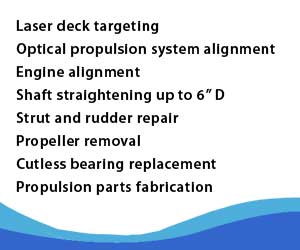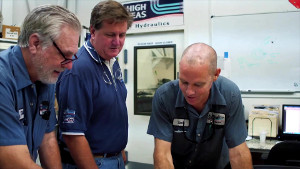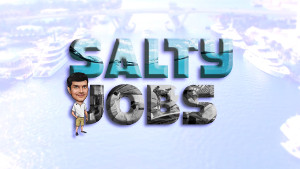In vs. Out of Water Alignments
During the course of a conversation with a new client we were talking about the benefits of an optical scope alignment when the shafts are removed. The client had heard, as many have, that the best alignments must be made in-the-water. We hear this argument (in vs. out of the water) often and appears to be a chicken-and-egg discussion that creates a lot of confusion.
Here is what we discussed:
The first stage is aligning the transmission flange in an X Y dimension so that it is centered (aligned) accurately with the strut and shaft log. This process places the aft end of the engine in the right location up or down, inboard or outboard by adjusting the aft engine mounts. This can only be accomplished accurately out of the water with the shaft removed. If a boat is in the water (obviously with the shaft in place) it is impossible to know the engine alignment location. To attempt this in the water yields false results; a shaft will always be lower than proper alignment due to the weight of the shaft and coupler. The shaft could also be pushed in one direction due to unusual side loads from the stuffing box.
The second stage involves “squaring up” the engine to the alignment line (the Z dimension) so the transmission flange and shaft coupler mate together within 0.001″. To make this adjustment you are focusing primarily on the forward engine mounts. A skilled scope technician will get the Z orientation aligned within a few thousandths of an inch during the overall alignment process while the boat is out of the water.
However, we do agree that it is good practice to check the final “squaring up” alignment in the water. There could be small adjustments made when a boat settles in the water even for stiff boats that do not require deck targeting. The procedure involves loosely bolting the coupler to the transmission and, once in the water, check the face gap with a feeler gage. We look for a gap all the way around of 0.001″ or less. It is critical that the coupler remain on the transmission flange pilot for this step and adjustments only involve “squaring up” and moving the forward mounts.
The biggest mistake we see is an attempt to make an in-the-water alignment by taking the coupler off pilot. Once off pilot you have no idea where the shaft should be for a proper X Y alignment and once the aft mounts are adjusted to this scenario the motor will almost always be dramatically out of alignment. If this is done there is no way to get back to a proper alignment without coming out of the water.
So, in or out of the water? It depends. If you know the X Y is in alignment and you want to make adjustments to the forward mounts to get a good Z alignment – go for it. But please do not take the shaft off pilot and lower the motor down – you are only aligning to a shaft that is bending under its own weight and causing further damage to bearings and transmissions.
See you on the water.


 Click to watch the video of a day at High Seas Yacht Service.
Click to watch the video of a day at High Seas Yacht Service. Click to watch Marine Industries Association of South Florida video featuring Salty Jobs at High Seas Services.
Click to watch Marine Industries Association of South Florida video featuring Salty Jobs at High Seas Services.